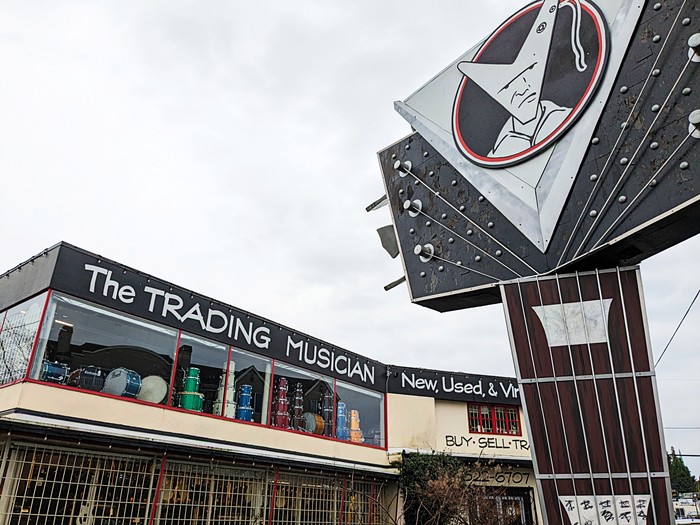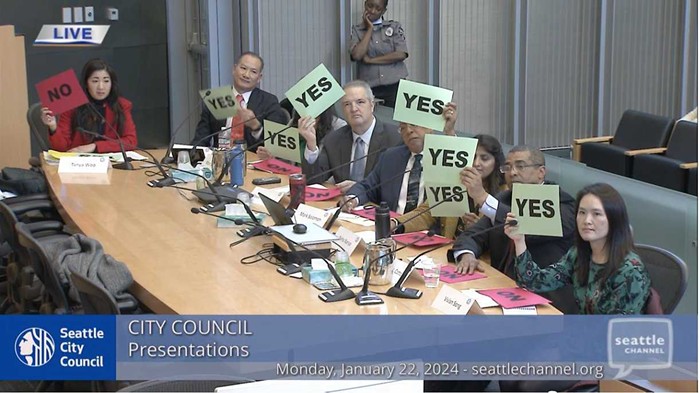
Today, the federal Department of Transportation finally published rules to regulate oil trains. These trains have a history of derailing and shooting fireballs several hundred feet high into the sky, and currently run directly beneath downtown Seattle multiple times a week.
It's been nearly five months since the DOT missed its deadline to come up with safety standards for highly flammable oil-train shipments. What they did eventually come up with, a rule that is 395 goddamn pages long, can be difficult to digest. And lots of people are upset about the pieces it sidestepped or left out.
Here are a couple of the most straightforward sections to understand: The rule says that older train cars, the DOT-111s, have to be replaced by 2018. And newer model cars, called CPC-1232s, have to adapt to the latest standard, something called the DOT-117, by 2020. And all trains carrying large amounts of crude oil also have to have electronically controlled pneumatic brakes by 2021, a regulation that the railroad industry dislikes.
But not everyone agrees 2018 is a fast enough timeline to phase out old cars, and other parts of the rule make significantly less sense, critics say.
Take speed limits, for example. With the newest standard, the DOT-117, tank cars won't be allowed to move through places called high-threat urban areas at speeds above 50 miles per hour. (Trains that don't adopt new standards have to travel below 40 miles per hour.) But high-threat urban areas sometimes have very little to do with population density near the tracks. The list of these high-threat urban areas, according to Earthjustice lawyer Kristen Boyle, was developed in consideration of terrorist attack targets. So, according to the list the Feds are using, the "Seattle area" is the only high-threat urban area in Washington State. It includes Seattle, Bellevue, and a 10-mile buffer around the two.
The list, however, does not include Spokane, which has a rail line transporting crude right through its downtown. Nor does it include Everett, whose railroad line runs right along the waterfront. In other words, the rules appear to be arbitrary.
Even though these speed limits seem like a good idea, crude-oil trains have also been known to derail at speeds much slower than the federal limit. The train full of Bakken crude that derailed in West Virginia in February was moving at 33 miles per hour. The Galena, Illinois, train that derailed in March had been traveling at 23 miles per hour. In the February Ontario accident, the train was going 38.
Senator Maria Cantwell (D-WA) slammed the new rule in a statement: "The new DOT rule is just like saying let the oil trains roll. It does nothing to address explosive volatility, very little to reduce the threat of rail car punctures, and is too slow on the removal of the most dangerous cars. It’s more of a status quo rule than the real safety changes needed to protect the public and first responders."
Ah, the public. Instead of adopting disclosure rules to make routes and hazards more transparent, the new rule formalizes an emergency order put in place last year. It requires railroads to give some information to state first responders, but past that, the public has to do the work.
"This final rule really is awful on public disclosure," Earthjustice attorney Boyles said. "They are back to where they were on 'We're just going to give a certain amount of information to the states, and let the states figure out what they're going to do with it.' And that's just a terrible idea for communities."
Sean Dixon, a staff attorney at Hudson Riverkeeper, a New York environmental group, said that the new rule protects industry propriety at the expense of public transparency. "It puts the onus on communities to call up state and railroads to see if they can share information with first responders, [and] allows states to limit disclosures to the type of product moving through—not the rates, not the specific routing lines," he said. "It does create this burden on local communities to seek out things that should be shared."
But there are other ways of seeking out things that should be shared. Just last week, local activists organized a 24/7 coal- and oil-train watch in Snohomish County and Seattle. Forty volunteers took four-hour shifts of "trainspotting" to count how many coal and oil trains passed by on local rails. They took notes on the types of cars on the tracks, the number of them, and the type of cargo (if it was easily determined), then uploaded the information to a database built by the group's organizer, Dean Smith.
The train watch counted 29 coal trains and 12 crude trains, an increase in coal and decrease in oil from last year. Snohomish County activists also organized a mock evacuation from neighborhoods immediately adjacent to the tracks... on a budget of $30.
"We would like to see this kind of evacuation drill repeated in the fall, closer to the greatest danger season for landslides onto the railroad tracks," the group wrote. "Next time, the Everett Fire Department and [national Community Emergency Response Team] volunteers should take the lead."


















